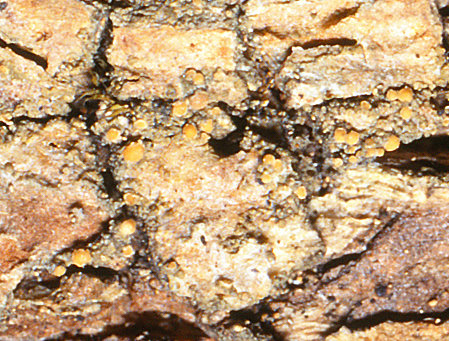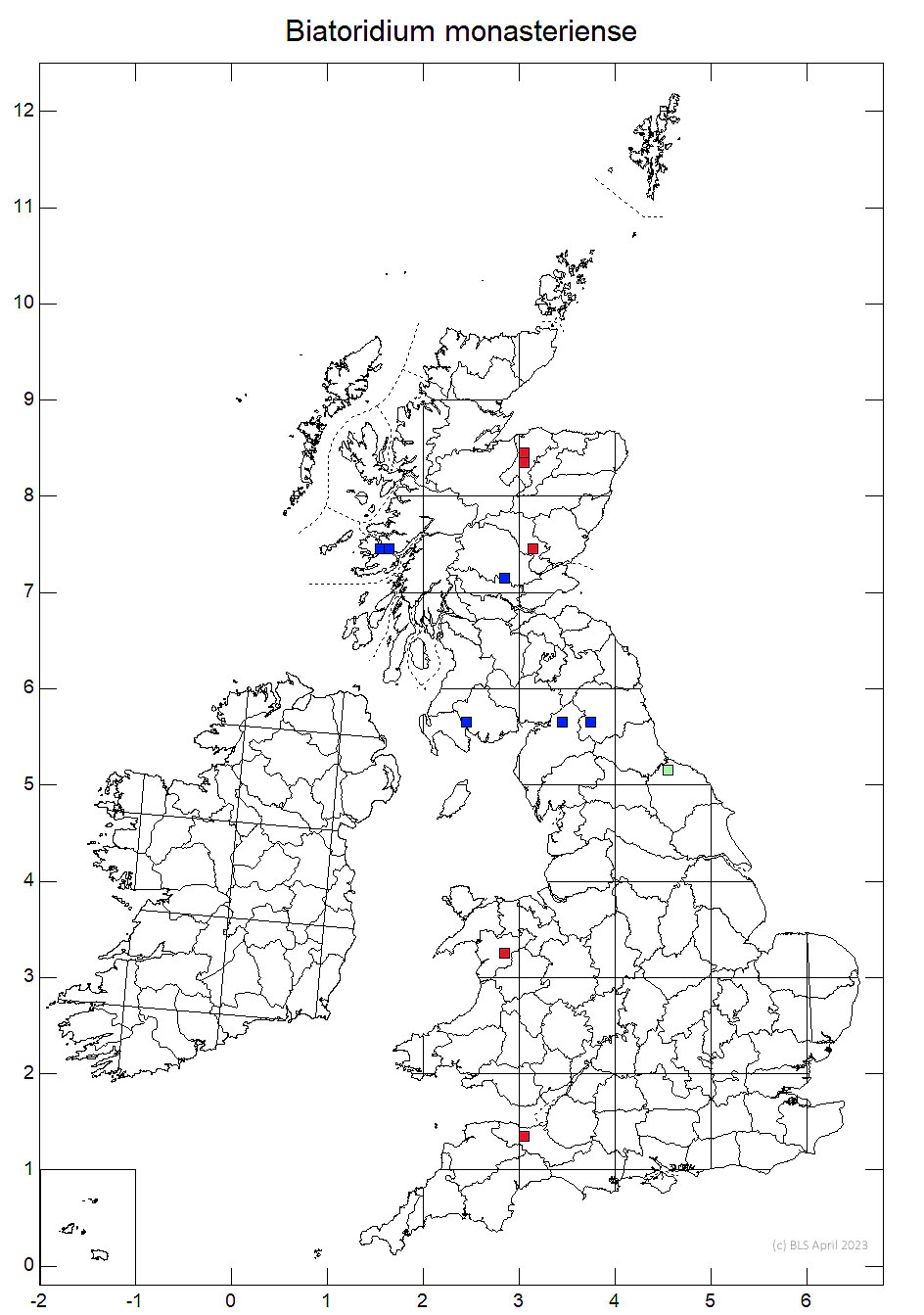Biatorella monasteriensis
B. monasteriense is a crustose epiphytic lichen with a scurfy thallus which is pale green when dry and bright green when moist. Apothecia are numerous, 0.2-0.5 mm diameter, yellowish, reddish yellow or pale pink top dull red-brown in colour, becoming translucent and paler when wet. They can be flat or convex, partly immersed in the thallus or sessile.

Photo: V. Alstrup
In the field the mealy-scurfy crustose growth form of this species, and the pale brown to yellowish or pinkish-brown fruits becoming convex, can superficially resemble some other scarce lichens, particulalry Lecania species such as L. chlorotiza, which is found in similar situations on basic bark. Microscopic examination is essential for correct determination. This need not constitute a conservation threat, as a single fruit will suffice. At x20 the dull green (when dry) flattened thalline verrucae are distinctive and recognisable with practice (but in poorly developed material these are very inconspicuous).
Confusion is also possible with the even rarer Biatoridium delitescens. That species, however, has an inapparent to finely scurfy thallus and pallid, almost white (translucent when moist) flatter apothecia, but darkening pale brown after several months in dry storage. (SPC)
This is a species of damp and sheltered situations within upland ancient woodland in ravines and stream valleys. It exhibits a strong preference for basic-barked phorophytes susch as ash (Fraxinus excelsior), elder (Sambucus nigra) and wych elm (Ulmus glabra). It has been recorded on poplar (Populus) in Sweden. It appears to be highly selective for bark chemistry (pH and nutrient levels) and bark physical/ultrastructural characteristics (porosity, water absorption and retentiveness), occurring on trees with a suitable soft and spongy, basic bark. It is shade tolerant. moderately anombrophilic, absorbing moisture direct from bark and /or from humid air rather than from direct incident precipitation. Consequently it is often found growing chasmophytically along sheltered crevices low down on trunks. (SPC)
Widespread but scattered in Europe, with strongholds in Switzerland and Germany. In Britain it is only currently know from seven 10 km squares in England and one in Wales.
| Location | Grid Reference | Last Rec'd | Recorder(s) | SSSI |
| Meirionydd: Coed Allt y Benglog NNR | SH 808 236 | 2002 | S.P. Chambers & C. Hitch | Yes |
Coed Allt y Benglog NNR - B. monasteriense has only ever been recorded at this single site in Wales, in a narrow wooded ravine of the Afon Eidedon. It was first discovered here by P.W. James in 1960. Steve Chambers and Chris Hitch confirmed its presence in the same location in 2002 and details of location, habitat, substrate etc. are given in Chambers (2003) - see below.
UKBAP Signposting Actions:
| 1. | More work needed to survey historic sites and also likely habitat. |
| 2. | Monitor the habitat and species at sites, at least every 6 years, to ensure that owners and occupiers continue to be aware of the importance of the site and that management maintains and/or expands suitable mature native trees, paying special attention to threats from excessive shade cast by climbers and evergreen trees and shrubs, particularly invasive non-native species and inappropriate grazing levels, forestry operations or adjacent land uses. |
Chambers, S.P. (2003). Site dossiers for the UK BAP lichens Biatoridium monasteriense, Cladonia peziziformis, Graphina pauciloculata and Schistmatomma graphidioides
- Log in to post comments

